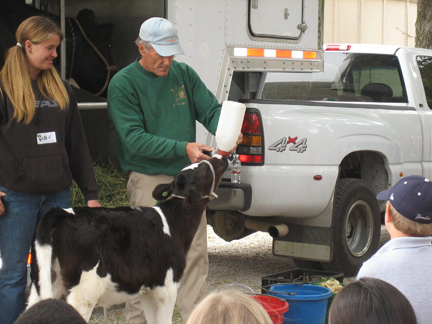
Kids enjoy San Benito farm day
San Benito’s annual farm day drew thousands of third-grade
students from around the region and hundreds of volunteers for a
day devoted to the top industry in the county.
Kids enjoy San Benito farm day
San Benito’s annual farm day drew thousands of third-grade students from around the region and hundreds of volunteers for a day devoted to the top industry in the county.
Tractors and farm equipment parked along the edge of Bolado Park, while 4-H and FFA members set their animals up near the arena. Parked along picnic benches was a mobile dairy classroom sponsored by the Dairy Council of California.
“I like coming out here,” said Jeff Byers, an instructor for the mobile dairy classroom. “It’s like coming in from days gone by and the kids really enjoy themselves.”
Byers’ presentation proved a popular one as students from several schools gathered around for a closer look at Ellie, a dairy cow from Moonglow Dairy in Moss Landing.
Byer held up an artichoke and other pieces of vegetables that Ellie enjoys eating.
“From that, they make milk and we can make all sorts of things, such as cheese and ice cream,” he said. “Next time you have ice cream, think of carrots and celery.”
Later in the presentation, Byers demonstrated how cows are milked by hand. The students closest to Ellie, a group from Sacred Heart School, squealed as Byers squirted them with warm milk from the cow.
With calf Della, Byers showed how farmers feed the calves with a bottle.
“If you give her warm milk, she thinks she is getting it from her mom,” Byers said.
When Della is 15 months old, she will be bred and will start producing milk after her first calf is born.
Byers showed students a green tag on Della’s ear.
“I put a tag on her ear when she was three days old,” he said, “And if you want, I can put a tag on you, too.”
The children giggled.
Dairy cows weren’t the only thing for students to see around Farm Day.
The Fairview 4-H group brought out animals synonymous with spring – bunnies. Dressed in 4-H white, with green hats, the kids held out bunnies of all different colors. Visiting third-graders lined up to pet the fuzzy animals.
While some students touched the soft coats of bunnies, a group of Gabilan Hills students gathered around a cow named Turbo.
“Turbo weighs 875 pounds,” said Glen Alameda, of San Juan 4-H.
Alameda and Grace Tobias explained the difference between some varieties of cattle and how to care for a cow’s coat.
“Angus cattle, which are black, came from Scotland,” Tobias said, as she held up photos of a cow. “Charolais, which are all white, came from France.”
Alameda held up three different brushes for the students to see that are all used to groom the cow. He also showed a variety of spray cans with cleansers that help loosen dirt from the coat.
During the question and answer period, Alameda dispersed an often-cited myth.
“Cows don’t have four stomachs,” he said. “Cows have one stomach with four compartments.”
Other animals included goats, sheep and horses.
“Educating them,” is the best part, Tobias and Alameda said, of presenting to the third-graders.
In addition to the livestock, students learned about orchards in the region. Mari Rossi, of B&R Farms, talked the students through the growing cycle of apricots.
“Apricots have a soft, pink blossom,” Rossi said, adding that the abundant white blossoms in orchards around the county right now are from cherry trees.
She handed the students branches from an apricot tree that had tiny apricots smaller than a blueberry.
“This year we had a really, really big blossom and we like that because we have more fruit,” she said. “But that also means we have more work to do.”
In two weeks, she told the students, the apricots will be the size of grapes. They won’t be ready to pick until around July 4.
At the end of the afternoon, the students had learned plenty about agriculture.
“They don’t just go to the store,” said Alameda, who had presented about beef. “They get to see what goes on the table and where it comes from.”
Melissa Flores can be reached at mf*****@**********ws.com.









